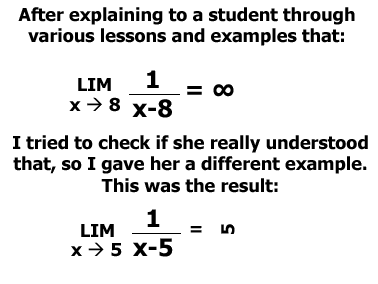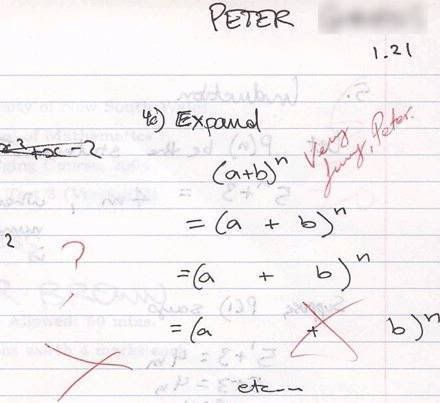HAHA!!! Math funnies..
- Thread starter N8 v2.0
- Start date
Never, ever, ever.... divide by zero!the top one , must have been a blond!
this one's corny, but in my calculus class a korean sudent said this, "I want to be your derivative, so I can be a tangent to your curve."
...she was not impressed
...she was not impressed
I have notoriously bad handwriting. I remember taking a differential equations quiz where I had to prove that one formula was equal to another. I simply wrote the first formula, wrote it again really messy, wrote the first half of the first formula really messy along with the second half and so on until I had the second formula. Dumba ass TA who was grading it gave me half credit.
Oh yeah, that's one of my signature moves... and "d" can look alot like an "a" on an answer sheet if you're sly enough:biggrin:I have notoriously bad handwriting. I remember taking a differential equations quiz where I had to prove that one formula was equal to another. I simply wrote the first formula, wrote it again really messy, wrote the first half of the first formula really messy along with the second half and so on until I had the second formula. Dumba ass TA who was grading it gave me half credit.
A constant function and e^x are walking on down the street. Then suddenly the constant function sees a differential operator approaching and runs away.
So e^x runs after the constant function and asks why the hurry. "Well, you see, there's this differential operator coming this way, and when we meet, he'll differentiate me and nothing will be left of me...!"
"Ah," says e^x, "that mother****er won't bother ME, I'm e to the x!" and heads back.
Of course he meets the differential operator after a short distance and says with a sneer, "Hi, I'm e^x."
The differential operator replies, "Hi, I'm d/dy."
i bet most of you wont get that.
So e^x runs after the constant function and asks why the hurry. "Well, you see, there's this differential operator coming this way, and when we meet, he'll differentiate me and nothing will be left of me...!"
"Ah," says e^x, "that mother****er won't bother ME, I'm e to the x!" and heads back.
Of course he meets the differential operator after a short distance and says with a sneer, "Hi, I'm e^x."
The differential operator replies, "Hi, I'm d/dy."
i bet most of you wont get that.
If it was two years ago, I would have gotten it. I get why the constant is running, and I'm sure the punchline has to do with d/dx, but other than that I'm lost.A constant function and e^x are walking on down the street. Then suddenly the constant function sees a differential operator approaching and runs away.
So e^x runs after the constant function and asks why the hurry. "Well, you see, there's this differential operator coming this way, and when we meet, he'll differentiate me and nothing will be left of me...!"
"Ah," says e^x, "that mother****er won't bother ME, I'm e to the x!" and heads back.
Of course he meets the differential operator after a short distance and says with a sneer, "Hi, I'm e^x."
The differential operator replies, "Hi, I'm d/dy."
i bet most of you wont get that.
:biggrin: Everyone likes a good differentiation joke.Of course he meets the differential operator after a short distance and says with a sneer, "Hi, I'm e^x."
The differential operator replies, "Hi, I'm d/dy."
Isnt the 1st derivative of e^x going to be ex? (going on 20 yrs since college, so I might be wrong)doesn't d/dy reduce e^x to just x?
What is the difference between d/dy and the 1st deriv?
So what is the answer?

You guys... LOL. Differentiating e^x with respect to x is equal to e^x, yes. However differentiating e^x with respect to y is equal to 0. Therein lies the joke. Duh!
edit: ninja'ed by n8.
edit: ninja'ed by n8.
Math Problem
Advanced Mathematics: Curve Superelevation
What is the superelevation of the outer rail above the inner rail of a 2° railroad curve with a 70 mph design speed if the friction factor is neglected?
a. 8 ½ in
b. 7 ¼ in
c. 6 ½ in
d. 5 ¼ in
Advanced Mathematics: Curve Superelevation
What is the superelevation of the outer rail above the inner rail of a 2° railroad curve with a 70 mph design speed if the friction factor is neglected?
a. 8 ½ in
b. 7 ¼ in
c. 6 ½ in
d. 5 ¼ in
duh!45You guys... LOL. Differentiating e^x with respect to x is equal to e^x, yes. However differentiating e^x with respect to y is equal to 0. Therein lies the joke. Duh!
edit: ninja'ed by n8.
i feel stupid not being able to get this. after all, this is what we are currently covering in ap calculus.You guys... LOL. Differentiating e^x with respect to x is equal to e^x, yes. However differentiating e^x with respect to y is equal to 0. Therein lies the joke. Duh!
edit: ninja'ed by n8.
 but then again, we are focusing more on derivatives than we are on differentials currently.
but then again, we are focusing more on derivatives than we are on differentials currently.You guys... LOL. Differentiating e^x with respect to x is equal to e^x, yes. However differentiating e^x with respect to y is equal to 0. Therein lies the joke. Duh!
edit: ninja'ed by n8.
This is the reason I'm in ap statistics.
stats =

calc =
 or teh suck
or teh suckNo, N8 was dead wrong:You guys... LOL. Differentiating e^x with respect to x is equal to e^x, yes. However differentiating e^x with respect to y is equal to 0. Therein lies the joke. Duh!
edit: ninja'ed by n8.
"i really don't think d/dy is gonna do anything to e to the x". It's going to turn e^x to nothing, which, as you observed, is the point of the joke...
No, N8 was dead wrong:
"i really don't think d/dy is gonna do anything to e to the x". It's going to turn e^x to nothing, which, as you observed, is the point of the joke...
yes... x = 0
its been a while
I guess I was making the erroneous assumption that n8 actually knows more than what most people give him credit for when in fact the converse is true. This shall be a lesson to us all. Do not underestim8 n8....0 != nothing
I'm going to make a guess and say that the super elevation is small at that speed and radius so I'll go with answer d. I'm too lazy to work it out (don't feel like doing the unit conversions) but here is the equation: h = V^2*s/gRMath Problem
Advanced Mathematics: Curve Superelevation
What is the superelevation of the outer rail above the inner rail of a 2° railroad curve with a 70 mph design speed if the friction factor is neglected?
a. 8 ½ in
b. 7 ¼ in
c. 6 ½ in
d. 5 ¼ in
V = velocity, 70 mph
s = track guage (not given??? n8, you're slipping.)
g = acceleration due to gravity 32.2 ft/sec^2
R = radius of curve (you have to convert 2° to a radius. I believe that the railroad defines this as the angle between the tanget of the curve and a chord length of the arc, how they define the chord length I don't know)
I'm going to make a guess and say that the super elevation is small at that speed and radius so I'll go with answer d. I'm too lazy to work it out (don't feel like doing the unit conversions) but here is the equation: h = V^2*s/gR
V = velocity, 70 mph
s = track guage (not given??? n8, you're slipping.)
g = acceleration due to gravity 32.2 ft/sec^2
R = radius of curve (you have to convert 2° to a radius. I believe that the railroad defines this as the angle between the tanget of the curve and a chord length of the arc, how they define the chord length I don't know)
Solution:
What's the weight of the train? The inertial force on the exterior railing would be directly proportional to the lateral sway of each individual boxcar. If the lead boxcar (A) was 1/3 heavier than the next boxcar (B), it would create a greater pivotal momentum about the rotational plane of the longitudinal axis along the arc of the rails. However, if boxcar B weighs less than A, then just the opposite would occur. In other words, it would be pushing the lead car (A) which if the rail is not high enough, it could have a tendency to push it off the edge of the outer rail. However, if we take each individual sprocket of the boxcar and multiplied the instantaneous center of rotation (ICOR) of each wheel times the velocity(not speed, we need a vector quantity and only velocity has that), each would create an individual value that when added would be the sum total of the all the tangential accelerations--this would give us a value that will alleviate the lesser degree of superelevation.
Here's the kicker, if A weighs more than B, then D would be the answer. If B weighs more than A, answer B would be correct due to the outside rail would be substantially higher than the inner rail. If all boxcars were assumed to be the same, then the answer should be "C".
Solution:
What's the weight of the train? The inertial force on the exterior railing would be directly proportional to the lateral sway of each individual boxcar. If the lead boxcar (A) was 1/3 heavier than the next boxcar (B), it would create a greater pivotal momentum about the rotational plane of the longitudinal axis along the arc of the rails. However, if boxcar B weighs less than A, then just the opposite would occur. In other words, it would be pushing the lead car (A) which if the rail is not high enough, it could have a tendency to push it off the edge of the outer rail. However, if we take each individual sprocket of the boxcar and multiplied the instantaneous center of rotation (ICOR) of each wheel times the velocity(not speed, we need a vector quantity and only velocity has that), each would create an individual value that when added would be the sum total of the all the tangential accelerations--this would give us a value that will alleviate the lesser degree of superelevation.
Here's the kicker, if A weighs more than B, then D would be the answer. If B weighs more than A, answer B would be correct due to the outside rail would be substantially higher than the inner rail. If all boxcars were assumed to be the same, then the answer should be "C".
Ok??? That makes very little sense, I think I need to see a picture. What is the equation for the solution? That's not a very 'real world' answer, because a you don't know the weigh of the cars a priori and you can't realistically change to superelevation to match the train as it passes. But I think it (the heavier cars pushing the lighter cars through the turn) is why they tend to put the empties at the back of the train.
-
This site uses cookies to help personalise content, tailor your experience and to keep you logged in if you register.
By continuing to use this site, you are consenting to our use of cookies.






 Except the "Women = Evil" part, that I understand.
Except the "Women = Evil" part, that I understand.